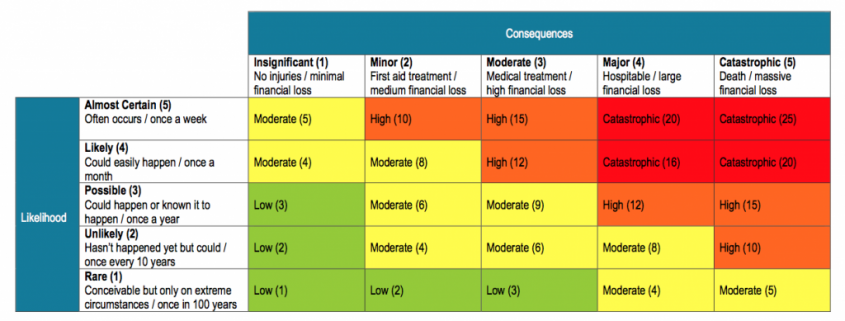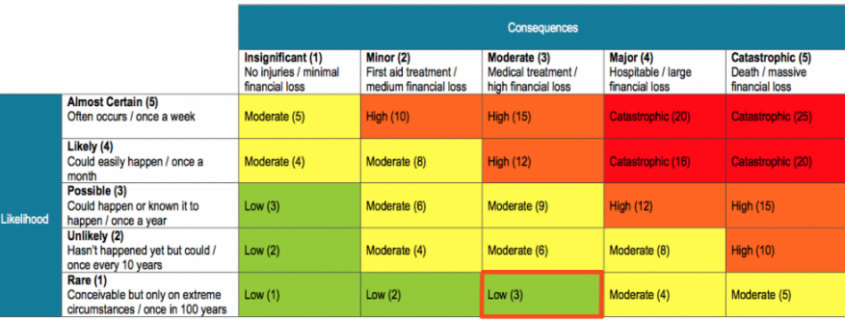Wrapping your head around the concept of a risk assessment matrix can be tricky without an example to guide the way. An OHS/WHS risk assessment matrix is part of any general risk assessment form and helps workers put a numerical value on the hazard and risk identification process. Further, it gives each worker a subjective way to assess the risks present to them in the workplace and rank them based on their own assessment.
This article covers an example of a risk assessment matrix.

Low Risk Rating (Green)
Moderate Risk Rating (Yellow)
High Risk Rating (Orange)
Catastrophic Risk Rating (Red)
As you can see in this hazard risk analysis matrix, every consequence and likelihood are given a numerical value. When multiplied together they give the total risk rating that correlates with a certain level of risk within the matrix. These levels of risk are identified by various colors and classifications. For example, a total risk rating value of 8 would be considered moderate (yellow) while a value of 20 would be catastrophic (red).
Example 1 – Low Risk Rating
The type of incidents that might fall into the low category could be hazards related to accessing a site. Think uneven surfaces causing slips and falls, materials on the ground causing trips etc. The type of hazards that fall into this level of total risk would be more general hazards rather than high risk job steps.
The likelihood of these events occurring is varied and depends on things like the condition of the site and general awareness. The consequences of these events are varied and could be made worse by factors like carrying tools or materials.
It is important to remember that total risk is a function of both likelihood and consequence. This means that an event could be rare but still carry moderate consequences such as injury requiring medical treatment and large financial loss. Refer to the matrix below for an example.
Example 2 – Moderate Risk Rating
The type of incidents that might fall into the moderate category could be related to performing minor or routine work at an established site. Think of loading or moving equipment into or on an elevated surface or carrying some materials with a buddy. In this category you are still generally dealing with site and environmental factors that become a hazard when completing routine tasks like manual handling.
These types of hazards would still fall into the category of a general hazard as it is still dealing with site conditions and moving about rather than high risk tasks. Think about all the hazards that might present themselves walking through a new site versus a site you are familiar with.
The severity of consequences in this level could also include risks to others around you, not just yourself. Think about a scenario where you and a buddy are carrying materials through a site. If you were to trip, it is likely they will also get hurt if they are helping you carry them. This would warrant a higher rating of consequence as two people would be hurt which may lead to greater financial loss even if the injuries are minor.
Example 3 – High Risk Rating
They type of incidents that might fall into the high category could be related to performing one of 18 high risk construction activities like working in confined spaces or disturbing asbestos. In performing one of these tasks a Safe Work Method Statement (SWMS) is required to effectively layout and document the process for mitigating these risks.
The likelihood of these incidents occurring is usually high as they are generally dangerous activities that require careful attention. Working at heights for example, there are many factors that could lead to a fall. With all of these factors being present, care has to be taken to mitigate the possibilities of an incident.
The types of consequences that might arise from an incident in the high category of risk are at minimum a minor injury requiring first aid up to the most severe, death. There is likely to be lost time and possibly damage to equipment. It is likely there will also be a component of financial loss for the company.
Example 4 – Catastrophic Risk Rating
Catastrophic events are things that are likely and have extreme consequences, often significant injury or death. A fall from a significant height such as from a mobile platform, falling through a rood opening or off the side of the roof. It could also be the risk to others if you are operating a piece of machinery that is likely to harm those around you.
These events are seen as highly likely to occur if no mitigations are put into place. This means that the task itself, without and safety procedures, is likely to lead to a significant injury or death. These hazards need to be carefully mitigated and reviewed in order to keep workers safe.
The consequences of these events are severe to both the worker involved and the company. The severity of a death at work should never be understated. With an incident like this there also comes a significant degree of financial loss and damage to the company’s reputation also.
Conclusion
This article should help you understand the risk matrix. It is important to note that the matrix is simply a tool used in a general risk assessment. In order to effectively use a risk assessment matrix a thorough understanding of the risk assessment process is needed.
Read More:


